The following lists events that happened during 1995 in South Africa.

The Rhacophoridae are a family of frogs that occur in tropical sub-Saharan Africa, South India and Sri Lanka, Japan, northeastern India to eastern China and Taiwan, south through the Philippines and Greater Sundas, and Sulawesi. They are commonly known as shrub frogs, or more ambiguously as "moss frogs" or "bush frogs". Some Rhacophoridae are called "tree frogs". Among the most spectacular members of this family are numerous "flying frogs".

Breviceps is a genus of frogs in the family Brevicipitidae. Species in the genus Breviceps are commonly known as rain frogs or short-headed frogs. They occur in arid to semiarid climates of Eastern and Southern Africa.

Lamellibrachia is a genus of tube worms related to the giant tube worm, Riftia pachyptila. They live at deep-sea cold seeps where hydrocarbons leak out of the seafloor, and are entirely reliant on internal, sulfide-oxidizing bacterial symbionts for their nutrition. The symbionts, gammaproteobacteria, require sulfide and inorganic carbon. The tube worms extract dissolved oxygen and hydrogen sulfide from the sea water with the crown of plumes. Species living near seeps can also obtain sulfide through their "roots", posterior extensions of their body and tube. Several sorts of hemoglobin are present in the blood and coelomic fluid to bind to the different components and transport them to the symbionts.

Hyperolius is a large genus of frogs in the family Hyperoliidae from Sub-Saharan Africa.
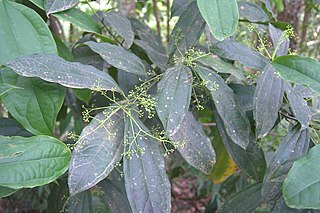
Aiouea is a genus of shrubs and trees in the family Lauraceae. It is native to tropical forests and montane forests of North and South America. The name is a curiosity because it consists entirely of vowels.

Gephyromantis is a frog genus in the mantellid subfamily Mantellinae. This genus is restricted to Madagascar. At present it contains 45 species divided into six subgenera.
Polhillia is a genus of flowering plants in the family Fabaceae. It includes 11 species of shrubs and herbs native to the Cape Provinces of South Africa. They grow in Mediterranean-climate renosterveld (shrubland) and scrub-grassland, typically in heavy soils. The genus belongs to subfamily Faboideae.
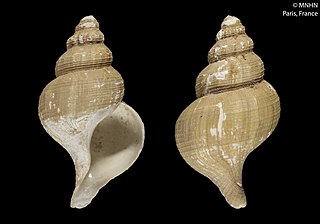
Mohnia is a genus of sea snails, marine gastropod mollusks in the subfamily Siphonaliinae of the family Buccinidae, the true whelks.

Klaus Rohde is a German biologist and parasitologist at the University of New England (UNE), Australia. He is known particularly for his work on marine parasitology, evolutionary ecology, zoogeography, phylogeny, and ultrastructure of lower invertebrates.
Symphylurinus is a genus of diplurans in the family Projapygidae.
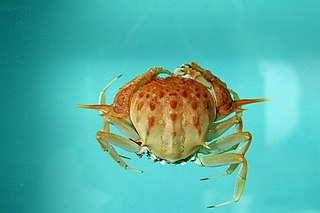
Acanthocarpus is a genus of crabs in the family Calappidae, containing the following species:
Candida blankii is a species of budding yeast (Saccharomycotina) in the family Saccharomycetaceae. The yeast may be a dangerous pathogen and resistant to treatment in human hosts. Research on the fungi has therapeutic, medical and industrial implications.

Opecoelidae is a family of trematodes. It is the largest digenean family with over 90 genera and nearly 900 species, almost solely found in marine and freshwater teleost fishes. It was considered by Bray et al. to belong in the superfamily Opecoeloidea Ozaki, 1925 or the Brachycladioidea Odhner, 1905.
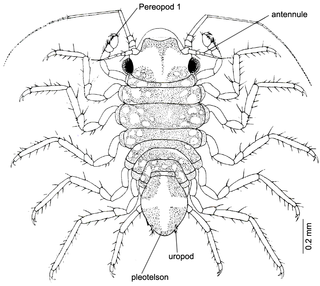
Uromunna is a genus of isopod crustaceans.

Poyntonophrynus, also known as pygmy toads, are a genus consisting of ten true toad species native to Sub-Saharan Africa. Originally, all Poyntonophrynus species were included in the genus Bufo. The genus was split due to large enough taxonomic divergence as evidenced by molecular markers. The genus is named in honour of John C. Poynton, South African herpetologist, with phrynus being Greek for toad.
Telorchis is a genus of trematode parasites found in many herps, comprising around 70 species. This parasite is an indirect parasite, with a snail intermediate host and a reptile or amphibian definitive host. Typically found in the gastrointestinal tract of their definitive host, telorchids attach to the wall of the intestinal tract with their ventral sucker, or acetabulum.

Breviceps carruthersi or the Phinda rain frog or Carruthers' rain frog is a species of frog in the Breviceps genus endemic to South Africa. The Phinda rain frog is also known as Isinana sakwaPhinda in IsiZulu which is the local language spoken in this species' native range. An IsiZulu description of this anuran amphibian species appears in a field guide called A Bilingual Guide to the Frogs of Zululand. This frog was first described by Professor Louis H. du Preez, Doctor Edward C. Netherlands, and Professor Les Minter in 2017, and they named it in honour of the naturalist and author Vincent Caruthers.
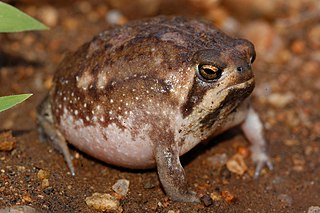
Breviceps passmorei, or Passmore's rain frog or Ndumo rain frog is a species of frog in the genus Breviceps endemic to South Africa.

Louis Heyns Du Preez is a South African professor of zoology who specialises in parasitology and herpetology at the North-West University. Du Preez is best known for his research on South African frog species, writing a widely used wildlife guide for the frogs of Southern Africa, and contributions to global parasitology with special focus studies on polystome worms. His contributions to polystome research have led to a recently discovered Malagasy frog species, Blommersia dupreezi, being named in his honour.















